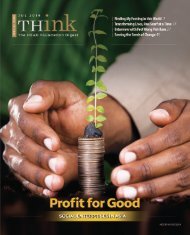Higher Education in Southeast Asia and Beyond #Issue 06
In this special issue, we feature articles arising from the 6th Global Higher Education Form 2018 (GHEF 6.0) held from 8 to 10 October 2018 in Putrajaya, Malaysia. We also look at China's influence and relationships in higher education, among other topics.
In this special issue, we feature articles arising from the 6th Global Higher Education Form 2018 (GHEF 6.0) held from 8 to 10 October 2018 in Putrajaya, Malaysia. We also look at China's influence and relationships in higher education, among other topics.
Create successful ePaper yourself
Turn your PDF publications into a flip-book with our unique Google optimized e-Paper software.
Australia’s<br />
Ch<strong>in</strong>a Question<br />
Anthony Welch<br />
As <strong>in</strong> a number of other countries,<br />
Australian views on the Ch<strong>in</strong>ese<br />
<strong>in</strong>fluence <strong>in</strong> higher education <strong>and</strong><br />
research have become a significant issue over<br />
the last year or more. In Australia, the debate<br />
is vigorous, touch<strong>in</strong>g on student enrolment<br />
trends, <strong>in</strong>ternet protocol <strong>and</strong> security issues,<br />
<strong>and</strong> Confucius Institutes, <strong>and</strong> has become<br />
rather polarised <strong>and</strong> politicised, with some<br />
critics charg<strong>in</strong>g that a few politicians are<br />
mak<strong>in</strong>g political mileage out of the issue.<br />
There are, however, two key differences <strong>in</strong><br />
Australia, compared to the United States<br />
<strong>and</strong> Canada. First is the extent of f<strong>in</strong>ancial<br />
dependence upon Ch<strong>in</strong>ese students among<br />
universities across the country. Second is the<br />
decision not to close any Confucius Institutes.<br />
Dependence on the Ch<strong>in</strong>ese “Market”<br />
As <strong>in</strong> a number of other major dest<strong>in</strong>ations<br />
for <strong>in</strong>ternational higher education<br />
students, <strong>in</strong>dividuals from ma<strong>in</strong>l<strong>and</strong> Ch<strong>in</strong>a<br />
comprise by far the largest cohort among<br />
<strong>in</strong>ternational students <strong>in</strong> Australia. Of the<br />
almost 400,000 <strong>in</strong>ternational students<br />
enrolled <strong>in</strong> Australian universities <strong>in</strong> 2018,<br />
Ch<strong>in</strong>ese students accounted for at least<br />
30 percent. While this is not necessarily<br />
different from other major English<br />
language systems such as the United<br />
K<strong>in</strong>gdom or the United States, the degree<br />
of f<strong>in</strong>ancial dependence on <strong>in</strong>ternational<br />
student <strong>in</strong>come among Australian<br />
universities is dist<strong>in</strong>ct. Recent data drawn<br />
from government auditors <strong>and</strong> <strong>in</strong>dividual<br />
university annual reports showed that<br />
among Australia’s top-tier “Group of Eight”<br />
(Go8) universities, several earned 30 percent+<br />
of their annual revenue from <strong>in</strong>ternational<br />
students. The University of Melbourne <strong>and</strong><br />
the University of Sydney each earned more<br />
than AU$750 million (US$532 million) from<br />
<strong>in</strong>ternational students alone. Given that<br />
more than 30 percent of this amount derives<br />
from Ch<strong>in</strong>ese students, it is no surprise<br />
that vice-chancellors around the country<br />
are nervous about any downturn <strong>in</strong> Ch<strong>in</strong>ese<br />
enrolments, <strong>and</strong> are seek<strong>in</strong>g to rapidly<br />
diversify the <strong>in</strong>ternational student <strong>in</strong>take<br />
at their <strong>in</strong>stitutions. It is partly for that<br />
reason that enrolments from India rose by<br />
32 percent <strong>in</strong> 2018, those from Nepal by 51<br />
percent, <strong>and</strong> those from Brazil by 10 percent.<br />
The University of Sydney’s Bus<strong>in</strong>ess School<br />
recently launched an AU$1 million feerebate<br />
scheme to attract 100 high-achiev<strong>in</strong>g<br />
students from other-than-Ch<strong>in</strong>a <strong>Asia</strong>n<br />
countries such as Korea <strong>and</strong> India.<br />
Security Concerns?<br />
For much the same reasons, university<br />
leaders have tended to resist the concerns<br />
expressed by some with<strong>in</strong> Australia’s<br />
security organs, such as the Australian<br />
HESB | SEPTEMBER 2019 | ISSUE #<strong>06</strong> | PAGE 31





